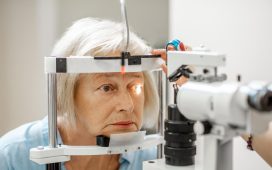By Beth Gilbert HealthDay Reporter
The annual meeting of the American Academy of Ophthalmology was held from Oct. 18 to 21 in Chicago and attracted participants from around the world, including ophthalmologists, optometrists, opticians, and other eye health care professionals. The conference featured presentations focusing on the latest advances in comprehensive eye care, including medical, surgical, and optical care.
In one study, Aidin Spina, of the University of California Irvine School of Medicine, and colleagues found that highly customizable three-dimensional (3D) printed glasses provide a simple yet innovative solution that improves access to specialized eye wear for any pediatric patient, even those with intracranial abnormalities.
From 61 individuals who underwent comprehensive eye exams, four children, aged 2 to 14 years, were selected to receive a pair of customizable 3D-printed glasses based on their unresolved refractive error and diagnosis of amblyopia or strabismus. The researchers say that these low-cost, highly customizable 3D printed glasses are a breakthrough in vision correction for all patients, including children with craniofacial abnormalities. The glasses are lightweight in design, affordable, customizable, and allow for ease of distribution. They do not require onsite 3D printing, which makes them ideal for use in medically underserved areas.
“These glasses expand the options available to all patients with craniofacial abnormalities, providing a significant improvement in visual acuity for those who typically have few choices for effective eye wear,” Spina said.
Among a population-based analysis of 163,663 adults with retinal disease, Winnie Yu, M.D., of the University of Toronto Temerty Faculty of Medicine, and colleagues assessed the risk for cataract surgery complications among patients who previously received intravitreal injections (IVIs).
The authors evaluated differences in the risk for cataract surgery-related complications in patients with retinal disease who previously received IVIs compared to those with no IVI history. Compared with no history of IVI treatment, the researchers found that prior IVI treatment increased the risk for nonclearing vitreous hemorrhage, retained lens fragments, retinal detachment, retinal tear, intraocular lens (IOL) dislocation, anterior vitrectomy, and glaucoma surgery following cataract surgery. However, there was no greater risk seen for corneal transplant, IOL exchange, or IOL repositioning.
“Findings of this study highlight the importance of preoperative and intraoperative surgical planning in the prevention and management of these possible complication events in patients receiving cataract surgery,” Yu said. “As well, patients with prior IVI history should be counseled of the potential risks of cataract surgery to ensure appropriate informed surgical decision-making.”
As part of the phase 2 ARCHER study, Rahul Khurana, M.D., of the Northern California Retina-Vitreous Associates in Mountain View, and colleagues found that ANX007, a C1q inhibitor, provides consistent, significant, dose- and time-dependent protection from vision loss among patients with geographic atrophy.
Patients with geographic atrophy were randomly assigned to intravitreal administration of ANX007 5 mg monthly, ANX007 5 mg every other month, or sham treatment for 12 months, with a six-month follow-up. The researchers found that ANX007 protected patients against vision loss from geographic atrophy and helped preserve retinal anatomy. Specifically, the novel agent protected structures in the central fovea, areas most closely correlated with vision. In addition, the researchers identified a more robust effect in patients with less-advanced disease.
“As a physician, I know my patients want to preserve vision so that they can maintain their quality of life,” Khurana said. “The therapies we have today for geographic atrophy protect [patients] from retinal pigment epithelium loss/lesion growth, but do not protect against vision loss.”
The ARCHER study was funded by Annexon, which is developing ANX007.
AAO: Prior Intravitreal Injections Increase Risk for Cataract Surgery Complications
WEDNESDAY, Oct. 23, 2024 (HealthDay News) — A history of multiple past intravitreal injections poses a risk for certain future cataract surgery complications, according to a study presented at the annual meeting of the American Academy of Ophthalmology, held from Oct. 18 to 21 in Chicago.
Read Full Text
AAO: One Year of Valacyclovir Beneficial for Herpes Zoster Ophthalmicus
WEDNESDAY, Oct. 23, 2024 (HealthDay News) — One year of valacyclovir is beneficial for patients with herpes zoster ophthalmicus, according to a study presented at the annual meeting of the American Academy of Ophthalmology, held from Oct. 18 to 21 in Chicago.
Read Full Text
AAO: Corneal Toxicity Reported With Mirvetuximab Soravtansine
TUESDAY, Oct. 22, 2024 (HealthDay News) — For patients receiving mirvetuximab soravtansine treatment for primary gynecologic malignancies, corneal toxicity is not uncommon, but usually resolves, according to a study presented at the annual meeting of the American Academy of Ophthalmology, held from Oct. 18 to 21 in Chicago.
Read Full Text
AAO: Wastage Seen With Artificial Expiration of Eye Drops in Ophthalmic Clinics
TUESDAY, Oct. 22, 2024 (HealthDay News) — Artificial expiration dates on eye drops in ophthalmology clinics result in significant waste in terms of medication, plastic, and cost, according to a study presented at the annual meeting of the American Academy of Ophthalmology, held from Oct. 18 to 21 in Chicago.
Read Full Text
Copyright © 2024 HealthDay. All rights reserved.








